The orange-robed monk greeted me in soft, measured English. He had just gently closed the massive, dark red teak doors of the temple behind him and carefully put on his sandals waiting for him on the steps. An umbrella hung by its handle from the crook of his left arm.
‘Where are you from?’
England I replied with a smile and short bow of the head to show respect.
‘Do you know the meaning of the doors?’
I didn’t and was glad of the opportunity to find out something about the history of Wat Phra Singh, the first of Chiang Rai’s five ancient temples I was planning to visit over the next two days. His voice was so calming that I quickly felt a feeling of tranquillity wash over me as he pointed to the four carvings of animals that towered above our heads. One door was decorated with a lion that represented fire and an elephant for earth. The other door bore mythical Buddhist creatures, a Garuda, which symbolised air and a many-headed serpent-like Naga that was water. All of these, the monk explained, form the four elements that are inside us all. He gestured that he had to go. 'Hope to see you again,' he said as he left.
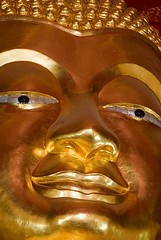
One of Chiang Rai's many golden Buddha images
Chiang Rai is a historic city that lies in the far north-east of Thailand. It sits on the edge of a flat plain at the foothills of the mountain range that forms the border with Myanmar and Laos. As the mountains rise to the north-east there lies the infamous Golden Triangle where once most of the world’s opium poppies were grown by hill tribes. Now the poppies have all but gone, replaced with tea, lychees and others crops promoted by the Thai government and the UN.
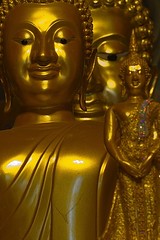
Three Buddhas
We visited between Christmas and New Year, when it seems that nearly half of Bangkok has decamped on holiday to eat in the Night Bazaar and pray in the temples known in Thai as wats. There are five historic temples in the town, each with a wooden hall inside a square compound. Most Thais visit all of them over two or three days. To sit or stand in a temple, where everyone is welcome, is to watch the Thais combine tourism and devotion in one visit. Small family groups shake off their flip-flops, trainers and shoes at the door, approach the Buddha statue to pray on their knees then take photos of each other in front of the Buddha.
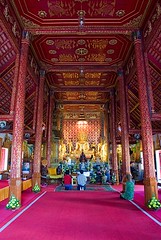
Wat Phra Singh

A monk given a blessing in Chiang Rai
Wat Phra Singh is known for its old doors and a statue of the Buddha in the style of the kings of Ayutthaya, the capital of Siam until the Burmese sacked it the 18th century. Nearby is Wat Phra Kaew, perhaps the most important of the city’s temples to Thais. It was here in 1434 that lightning struck the hall, splitting open the resident Buddha statue to reveal a smaller Buddha ornately carved from a single piece of jade. The original travelled across the region before settling in the main temple hall of the King in Bangkok. A replica on display in Wat Phra Kaew draws thousands of pilgrims every day. There is also an excellent museum that explains the symbolism and purpose of objects used in the temples such as trays, bowls and candlesticks as well as some of the temples’ architectural elements. The Buddha statues in main hall are unusual in being carved from burnished wood rather than golden.
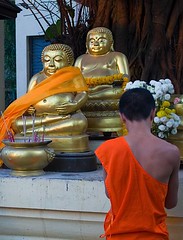
Outside Wat Phra Kaew
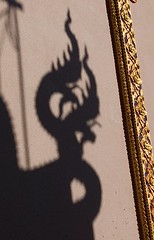
Wat Jet Yot is near the Night Bazaar and is really only notable for astrological paintings on its ceiling. Two wats are sat on top of two small hills to the west of the city; approached by paths lined by snaking dragon sculptures. Wat Ngam Meuang’s claim to fame is a shrine to King Mengrai, the 13th century monarch who founded Chiang Rai in 1262 AD to be his capital. His statue is garlanded with flowers and, somewhat unusually, small plastic toy elephants. A short walk along a quiet wooded road leads to the hilltop Wat Phrat That Doi Chom Thong which has a fine view of sunset across the distant hills and a very old chedi that locals claim as built in 940 AD despite Chiang Rai not being founded for another 300 years. It was fro this hill that King Mengrai surveyed the site for his new city.

King Mengrai

The view from Wat Phrat That Doi Chom Thong
I returned to Wat Phra Singh twice but sadly I never saw the umbrella wielding soft-spoken monk again. What I did was to look at the temple doors with a deeper understanding, turning the ornate carvings from mere pretty decorations to symbols of Buddhism belief.





No comments:
Post a Comment